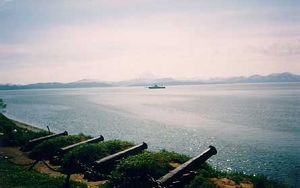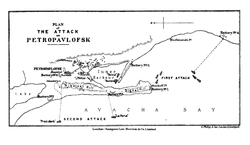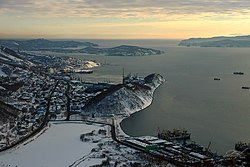Siege of Petropavlovsk-Kamchatsky
| date | August 18, 1854 to August 27, 1854 |
|---|---|
| place | Petropavlovsk-Kamchatsky |
| output | russian victory |
| Parties to the conflict | |
|---|---|
| Commander | |
|
Auguste Febvrier-Despointes |
|
| Troop strength | |
| 920 men 72 guns a warship, a transport ship |
2,600 men 218 ship guns 6 warships |
| losses | |
|
31 dead |
around 500 dead |
Olteniţa - Akhaltsikhe - Başgedikler - Sinope - Cetate - Silistra - Nigojeti - Tscholok - Odessa - Kurekdere - Petropavlovsk-Kamchatsky - Alma - Sevastopol - Bomarsund - Balaklava - Inkerman - Yevpatoria - Taganrog - Çorğun - Kars - Tschernaja - Malakoff - Kinburn - Third Paris peace
The siege of Petropavlovsk-Kamchatsky was the main scene of the Crimean War in the Pacific . The unsuccessful and loss-making siege was the only Allied attack on the Russian Empire in the Far East .
prehistory
The Russian Navy had only three ships in the Far East and was clearly inferior to the Allied forces stationed in the Pacific, which had nine ships with more than 200 cannons. After the outbreak of the Crimean War, the Russian admiral Evfimi Wassiljewitsch Putjatin relocated his flagship , the frigate Pallada , which is armed with 52 cannons, up the Amur in order to withdraw it from Allied access. He stationed his other two ships, Aurora and Dvina , in Petropavlovsk-Kamchatsky.
In Petropavlovsk-Kamchatsky the Russians had only a relatively small garrison of 920 men, consisting of 41 officers, 476 soldiers, 349 seamen, 36 Itelmen , 18 volunteers and 67 cannons. In the years before the Crimean War, Governor Nikolai Muravyov-Amursky had the city located in a sheltered bay fortified again. In the port of Petropavlovsk-Kamchatsky, the frigate Aurora (44 cannons), sheltered by a sandbank, and the transport ship Dvina (12 cannons) were positioned to support the garrison.
As expected by the Russians, the Allies planned an attack on the fortified naval base. For this purpose, the Allied commanders Auguste Febvrier-Despointes (1796–1855) and David Price (1790–1854) moved a formation of six ships to Kamchatka . Only three smaller units were left behind to protect maritime trade off the California coast.
The siege
The siege of the city began on August 18, 1854 when the Allied fleet anchored in the Avacha Bay off Petropavlovsk-Kamchatsky. When the Allied ships were positioning themselves on August 20 to attack the Russian defenses, British commander David Price was shot in the head. To date, it is not clear whether Price committed suicide or died in an accident. Frederick Nicolson, captain of HMS Pique , took command of Price on the same day and began shelling the Russian defenses two days later. After the destruction of several Russian batteries , around 600 Allied soldiers finally landed in the south of the city, but they were routed by 230 Russian defenders after heavy fighting.
After this initial failure, the Allies switched to blocking the city. On August 22, three American whalers who escaped the city reported possible vulnerabilities in the Russian defense. It is no longer possible to determine whether this information was true or falsified. However, based on this information, Febvrier-Despointes and Nicolson began another attack on the city on August 24th. After another shelling of Russian batteries, 970 marines and sailors landed again in the south of Petropavlovsk-Kamchatsky and were able to take the Nikolsky hill on the outskirts. Due to its sparse vegetation, however, the hill offered no cover for the Allied soldiers, who were now at the mercy of the fire of Russian snipers. The Allied ships could not fire their cannons over the hill and therefore could not provide any support. With heavy losses, the attackers had to admit defeat to only 360 defenders and retreat to their ships. The Russians captured a British flag, several officer's sabers, and large quantities of ammunition and weapons.
After this renewed defeat, the Allies continued their blockade, were able to sink the transporter Sitka and seize the schooner Avatska . They finally left Russian waters on August 27th.
Nikolai Muravyov-Amursky moved the city's garrison to another location in the Far East, fearing that it would not be able to answer another Allied attack.
literature
- MA Sergeyev, Defense of Petropavlovsk-on-the-Kamchatka, Moscow, 1954.
Web links
- Defense of Petropavlovsk (English)
- Crimean War 1854 (English)




